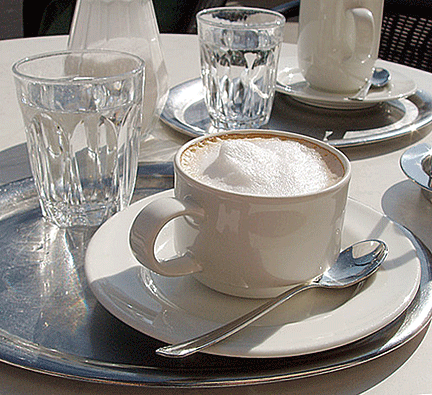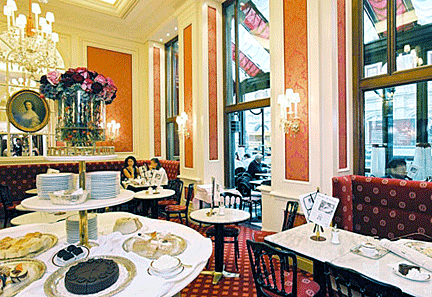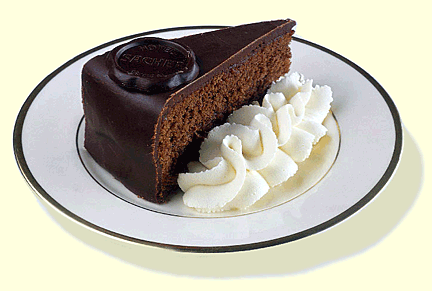 A crystal chandelier
glistens in the afternoon sun streaming through the lace-curtained
windows. A young waitress balances a tray of pastries and coffees on one
hand, while her patrons read the afternoon papers to the quiet strains
of Mozart's Symphony Number 9 in G-major. A crystal chandelier
glistens in the afternoon sun streaming through the lace-curtained
windows. A young waitress balances a tray of pastries and coffees on one
hand, while her patrons read the afternoon papers to the quiet strains
of Mozart's Symphony Number 9 in G-major.
The atmosphere is quiet and reserved. The sweet smell of chocolate and
fresh-brewed coffee mix with the heady smoke of European cigarettes. The
waitress delicately sets a large glass filled with dense coffee and a
dollop of ice cream topped with an Everest-like mound of whipped cream
on my table. Next to it she places a glass plate on which is a slab of
chocolate sponge cake, layered with rich chocolate icing and topped with
an immense , ruby-red strawberry. This is the Sacher Torte, one of the
many things for which Vienna has become well known.
Vienna has it all—beautiful buildings, graceful statues, grassy parks
where string orchestras play Mozart, Strauss, and Beethoven, and
delightful restaurants. It’s said that the Viennese work hard so that
they can enjoy life. And one of those pleasant joys to be found in this
city is in the hundreds of coffeehouses.
Coffeehouses in Vienna are not like any other. They’re little
neighborhood pastry shops and cafés where the Viennese can drop in
anytime, have some coffee and pastry while they read their daily
newspapers or check the latest news on their laptops. Although patrons
can stay as long as they wish without fear of upsetting the owners,
during busy hours, it’s the courteous thing to stay only a short time.
 Each Viennese coffeehouse is like a little jewel box, richly appointed
and cozy, offering shelter from the hustle and bustle of this modern
city. The institution dates back to 1683, when for two months Turkish
armies laid siege to the city, isolating it from the rest of the world.
Though Vienna's defenders numbered only about 15,000, the Turks almost
succeeded in breaking through its fortifications. Each Viennese coffeehouse is like a little jewel box, richly appointed
and cozy, offering shelter from the hustle and bustle of this modern
city. The institution dates back to 1683, when for two months Turkish
armies laid siege to the city, isolating it from the rest of the world.
Though Vienna's defenders numbered only about 15,000, the Turks almost
succeeded in breaking through its fortifications.
When a combined force of imperial troops and relief armies from
Lorraine, Bavaria, Saxony and Poland broke the siege, the Turks
retreated and left behind 300 cannon, 15,000 tents, and lots of coffee
beans.
The Austrian Emperor gave the beans to George Franz Kilschitzky, a
courier who repeatedly has passed through enemy lines, as a reward for
courageous deeds. Kolschitzky learned to roast and brew them and soon
opened a coffeehouse.
The strong brew quickly caught on in Vienna and then spread through the
rest of Europe. The coffeehouse flourished and café life became a part
of the Viennese scene. By the 19th century, most businessmen negotiated
their deals in coffeehouses. Men formulated philosophies and political
ideologies, wrote books and newspaper articles, analyzed textbooks and
lecture notes, composed symphonies, operettas and waltzes, began,
cultivated and terminated romances, conveyed letters and messages,
embellished memories and exchanged gossip.
Even in the 21st century Vienna's
coffeehouses still serve many of these functions. All cultivate the
mystique of coffee, offering different types and styles under a variety
of fancy and sometimes obscure names. The Viennese like their coffee
strong—with milk or cream. For instance, Melange is hot coffee with
steamed milk, while cold coffee with vanilla ice cream and whipped cream
served in a tall glass is known as Wiener Eiskafee. Pharisaer is coffee
with rum, sugar and whipped cream, while Kaffee Kirsch is hot coffee
with kirschwasser, the cherry brandy from
Switzerland--and so on, and so on.
 A variety of warm woods panel the walls in many while crystal sconces
beam romantic light and curtains hang in the windows. The walls sparkle
with polish, and tiny round ice cream tables stand in front of plushly
upholstered banquettes. Waiters wear pressed dinner jackets, while
waitresses wear black dresses with white, doily-like aprons. While the
atmosphere is formal, the air is informal and a hush-like library
environment prevails in some. A variety of warm woods panel the walls in many while crystal sconces
beam romantic light and curtains hang in the windows. The walls sparkle
with polish, and tiny round ice cream tables stand in front of plushly
upholstered banquettes. Waiters wear pressed dinner jackets, while
waitresses wear black dresses with white, doily-like aprons. While the
atmosphere is formal, the air is informal and a hush-like library
environment prevails in some.
Coffeehouse food ranges form open-faced Danish tea sandwiches to rich
creams and tortes. The variety of goodies is infinite—Napoleons, cream
puffs, tarts and cakes of every description, all topped with mounds of
whipped cream, known as Schlag. Coffeehouse owners also use Schlag
to lighten a cup of coffee. Many patrons, including myself, like
to eat it by the spoonful all by itself.
One of the most famous coffeehouses in this city of waltzes is the Cafe
Mozart on Albertinaplatz. Many visitors also stop into the Sacher Hotel
Café across from St. Stefan's Cathedral or Demel's, at Kohlmarkt 18, the
pastry palace to end them all. Forget the calories and indulge. |
